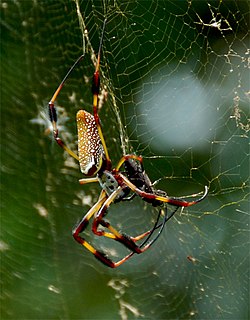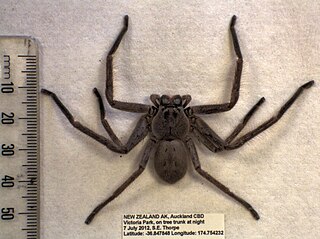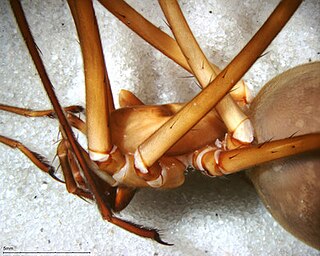Related Research Articles

Mensa is the largest and oldest high IQ society in the world. It is a non-profit organization open to people who score at the 98th percentile or higher on a standardised, supervised IQ or other approved intelligence test. Mensa formally comprises national groups and the umbrella organisation Mensa International, with a registered office in Caythorpe, Lincolnshire, England, which is separate from the British Mensa office in Wolverhampton. The word mensa is Latin for 'table', as is symbolised in the organisation's logo, and was chosen to demonstrate the round-table nature of the organisation; the coming together of equals.

Arachnology is the scientific study of arachnids, which comprise spiders and related animals such as scorpions, pseudoscorpions, and harvestmen. Those who study spiders and other arachnids are arachnologists. More narrowly, the study of spiders alone is known as araneology.

Wolf spiders are members of the family Lycosidae, from the Ancient Greek word λύκος, meaning "wolf". They are robust and agile hunters with excellent eyesight. They live mostly in solitude, hunt alone, and do not spin webs. Some are opportunistic hunters, pouncing upon prey as they find it or chasing it over short distances; others wait for passing prey in or near the mouth of a burrow.

The Royal Australasian Ornithologists Union (RAOU), now part of BirdLife Australia, was Australia's largest non-government, non-profit, bird conservation organisation. It was founded in 1901 to promote the study and conservation of the native bird species of Australia and adjacent regions, making it Australia's oldest national birding association. In 1996, the organisation adopted the trading name of Birds Australia for most public purposes, while retaining its original name for legal purposes and as the publisher of its journal, the Emu. In 2012, the RAOU merged with Bird Observation & Conservation Australia to form BirdLife Australia.
Bertmainius tingle, also called the tingle trapdoor spider, is a small basal spider endemic to the tingle and karri forest of southwestern Western Australia. This migid family species of Bertmainius was first recorded in the 1990s.

Australia has a number of highly venomous spiders, including the Sydney funnel-web spider, its relatives in the family Hexathelidae, and the redback spider, whose bites can be extremely painful and have historically been linked with deaths in medical records. Most Australian spiders do not have venom that is considered to be dangerously toxic. No deaths caused by spider bites in Australia have been substantiated by a coronial inquest since 1979. There are sensationalised news reports regarding Australian spiders that fail to cite evidence. A Field Guide to Spiders of Australia published by CSIRO Publishing in 2017 featuring around 836 species illustrated with photographs of live animals, around 381 genera and 78 families, introduced significant updates to taxonomy from Ramirez, Wheeler and Dmitrov
The International Society of Arachnology (ISA) promotes the study of arachnids and the exchange of information among researchers in this field. It acts as an umbrella organisation for regional societies and individuals interested in spiders, and related animals, and organises an International Congress every three years.

The American Arachnological Society (AAS) is a scientific organization founded in 1972 in order to promote the study of arachnids by seeking to achieve closer cooperation and understanding between amateur and professional arachnologists along with publication of the Journal of Arachnology. The society holds annual meetings around the United States and membership is open to all individuals who share the common objectives held by the society.
The Association for Academic Surgery is the world's largest organization dedicated exclusively to the promotion of surgical research. It has about 3,000 active and senior members. Its annual meeting is the association's main forum to communicate scientific progress in surgery. Until 2005, the association held its own meetings. These meetings were hosted by surgical university departments in the United States. In 2006, the organization merged its annual meeting with the annual meeting of the Society of University Surgeons to form the "Academic Surgical Congress".

Isopeda villosa is a species of huntsman spider native to New South Wales, Australia, and established in Auckland, New Zealand. It was first described by Ludwig Carl Christian Koch in 1875.
David B. Hirst is an arachnologist previously based at the South Australian Museum in Adelaide. He left the Museum on 22 February 2011. He has described more than 40 species and genera in the huntsman spider family, Sparassidae, and was regularly called on by New Zealand authorities to identify huntsman spiders that entered their country.
The Society for Underwater Historical Research (SUHR) was an amateur maritime archaeology organisation operating in South Australia (SA). It was formed in 1974 by recreational scuba divers and other persons to pursue an interest in maritime archaeology and maritime history. The SUHR was renamed as the South Australian Archaeology Society in March 2012 as part of a plan to expand its activities beyond maritime archaeology to include other archaeological disciplines.

Pekka T. Lehtinen is a Finnish arachnologist and taxonomist. He is known for his works in systematics and for the many expeditions in which he has participated.

Macrogradungula is a monotypic genus of Australian large-clawed spiders containing the single species, Macrogradungula moonya. It was first described by Raymond Robert Forster, Norman I. Platnick & Michael R. Gray in 1987, and has only been found in Australia. It is classified under the family Gradungulidae, superfamily Austrochiloidea, and suborder Araneomorphae.

Backobourkia is a genus of South Pacific orb-weaver spiders first described by Volker Framenau, Nadine Dupérré, Todd Blackledge & Cor Vink in 2010. It is a common Australian spider, closely related to Eriophora and placed in the "coxal hook clade" of the Araneinae subfamily of Araneidae. Females are generally the same size among all species, but males are much smaller, suggesting male dwarfism throughout the genus. The genus name is a play on the well known Australian idiom, "Back of Bourke", meaning very remote and beyond the limits of civilization.
Barbara Baehr is a German research scientist, entomologist, arachnologist, and spider taxonomist. She has described over 400 new spider species, mostly from Australia. She is originally from Pforzheim, Germany.

Anamidae is a family of Australian mygalomorph spiders. It was first described as a tribe by Simon in 1889, then raised to the subfamily Anaminae of the family Nemesiidae, before being raised to a family level by Opatova et al. in 2020.
Fred R. Wanless was a British arachnologist. Active in the field especially in the seventies and eighties of the 20th century, he described several dozen taxa, in particular among the spiders of the Salticidae family. Wanless played a significant role in the British Arachnological Society being its member in 1969–1973, 1974–1976 and 1986–1989, and Meetings Secretary in 1973–1978. From 1973 to 1988 he described 137 new species and 13 new genera.
References
- ↑ Official website
- ↑ "AAS - Australasian Arachnological Society - History". www.australasian-arachnology.org. Retrieved 27 July 2018.
- ↑ "Dr Volker W. Framenau". www.australasian-arachnology.org. Retrieved 27 July 2018.
- ↑ "Dr Cor J. Vink". www.australasian-arachnology.org. Retrieved 27 July 2018.
- ↑ "Michael Rix". www.australasian-arachnology.org. Retrieved 27 July 2018.
- ↑ Whyte, Robert; Anderson, Greg (June 2017). A field guide to spiders of Australia. Clayton, Vic. ISBN 9780643107083. OCLC 973390260.
- ↑ "Helen Smith - Australian Museum". australianmuseum.net.au. Retrieved 27 July 2018.
- ↑ Newsletter: ‘Australasian Arachnology’ (ISSN 0811-3696) on official website
- ↑ "AAS - Membership". www.australasian-arachnology.org. Retrieved 27 July 2018.